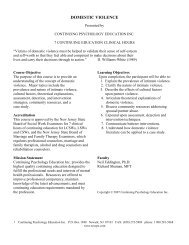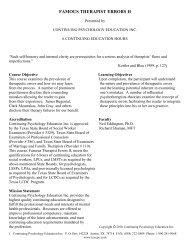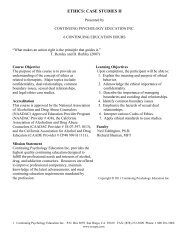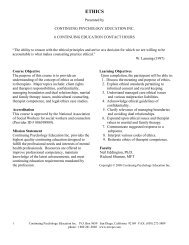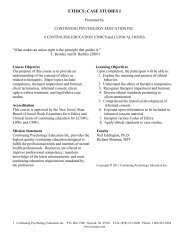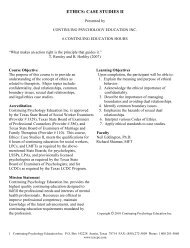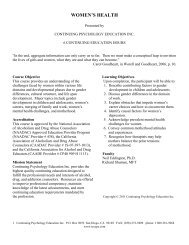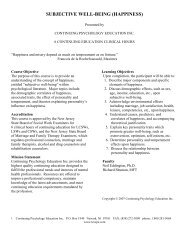FAMOUS THERAPIST ERRORS - Continuing Psychology Education
FAMOUS THERAPIST ERRORS - Continuing Psychology Education
FAMOUS THERAPIST ERRORS - Continuing Psychology Education
Create successful ePaper yourself
Turn your PDF publications into a flip-book with our unique Google optimized e-Paper software.
<strong>FAMOUS</strong> <strong>THERAPIST</strong> <strong>ERRORS</strong>himself as an alcoholic. Soon thereafter, Carlson received aphone call and visit from a police officer informing him of athreat against his life and that the police would patrol hisstreet on a regular basis. The past client had begun drinkingheavily leading to the loss of his job and control over his life.Ultimately, client was arrested for being out-of-control andhe threatened Carlson’s life while in detox. Client’s wifewrote therapist declaring him to be a terrible counselor andthat he ruined their lives.Carlson immediately reflected on the experience seekingresolution, he admitted, “It was really upsetting to me thatsuch a spontaneous passing remark could have such a hugenegative impact. Again I was right: research supported whatI had said but it was totally inappropriate for this individual.I learned after that to be very careful about the things I say topeople. At the very least, I might say to him now, “Wouldyou be interested in knowing …?” Or maybe I wouldn’tbring it up at all.” Therapist learned that he should havegiven the information in a different way, with greater respectto where the man was coming from. He felt sad that he nevertalked to client after this experience and that closure wasnever obtained.Carlson noted, “I have a lot of regret and sadness about theblessedly few failures I have encountered. They are storieswithout endings, and I have to live with that.” His currentbelief is that therapists do make mistakes but it’s important tonot continue making the same mistakes.PEGGY PAPPThis therapist is known for her innovative work exploringgender differences in the practice of family therapy. In heracclaimed book, The Process of Change and FamilyTherapy: Full Length Case Studies, she was one of the firstto trace family belief systems that affect core values ofindividual members. Other noteworthy books include, TheInvisible Web: Gender Patterns in Family Relationships, andCouples on the Fault Line: New Directions for Therapists.She has been a supervising faculty member of the AckermanInstitute for the Family and founder/director of Ackerman’sDepression and Gender project. Papp received the AmericanAssociation for Marriage and Family Therapy’s LifetimeAchievement Award, and she was honored by the AmericanFamily Therapy Academy for her ground-breaking work onThe Women’s Project for Family Therapy. She has been inprivate practice in New York while supervising therapists atNorth General Hospital.In recollecting a past therapy failure, Papp describedworking with a couple utilizing the technique of sculpting infront of a large crowd for demonstration purposes. Eachmember is asked to have a fantasy about their relationshipand then act out the fantasy together; the fantasies offer ametaphorical view of the way each member experiences therelationship and the metaphors are then used as a guide forbettering the relationship. Therapist recalled how the wifecould not derive a fantasy and the husband’s fantasy wasabout a rock which was difficult to sculpt. To make mattersworse, therapist intentionally did not have backgroundinformation on this couple – her therapeutic style is to formher own opinion rather than be potentially biased by areferring therapist – and this lack of information militatedagainst this demonstration as well. Ultimately, therapistcould only muster a “flimsy kind of message” back to thecouple and she felt it was the worst session she ever did.Papp felt that she ignored her intuition and continued towork within a structure that was not working. She learnedthat it is “unrealistic and inappropriate to decide ahead oftime on a treatment method before even meeting the familyand hearing their story. Such a structure was eventuallybound to fail.” Certainly, it is important to not remainfocused on a specific treatment or plan when the flow ofinformation suggests a different approach.Upon reflection, Papp concluded, “… no matter how longyou practice therapy, even in the most stressful ofcircumstances, you can never really get to the point whereyou can handle everything deftly that comes your way.There are therapists who think they can, but that is onlybecause they are oblivious to the different ways they couldhave proceeded.” She believes that human behavior ismysterious and unpredictable thus rendering therapists to behumble about their work, otherwise, we can be insensitive tothe dilemmas of our clients. Papp contends that “It takeswisdom sometimes, not techniques and approaches to behelpful to people. It takes a kind of real understanding abouthuman suffering.” Finally, she stresses the need fortherapists to work within the particular cultural context ofeach client and to respect those beliefs.VIOLET OAKLANDERThis pioneer of child and adolescent therapy has attainedinternational recognition and has received several awards forcontributions to the mental health field. Her books, Windowsto Our Children: A Gestalt Therapy Approach to Childrenand Adolescents, and Hidden Treasure: A Map to the Child’sInner Self reveal her unique Gestalt and Expressive Therapytechniques.In sharing an example of her bad therapy, Oaklanderdescribed a 16 year-old boy who was reluctantly attendingtherapy at his father’s request and whose mother was analcoholic. The youth disclosed many physical complaints,including chronic stomach aches which eventually led toulcers. He was passive, quiet, restricted in self-expression,and admitted to skipping a lot of school. Client becameemotional several times upon admitting he could not invitefriends to the house because his mother was drunk. Therapistfelt progress was occurring and that client would perhapsexperience a catharsis soon, however, after six sessions clientrefused to continue attending therapy because, in his words,“I feel things. And I don’t like it. I don’t want to feel what Iam feeling.” Further probing revealed that he recently criedin the classroom when criticized by his teacher and he yelledat an acquaintance who made him mad. He said, “I don’t6 <strong>Continuing</strong> <strong>Psychology</strong> <strong>Education</strong> Inc.



